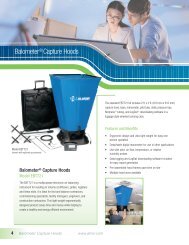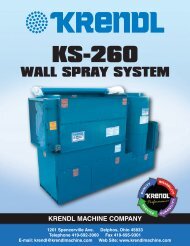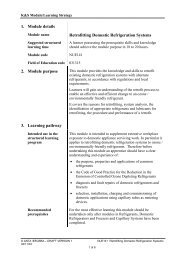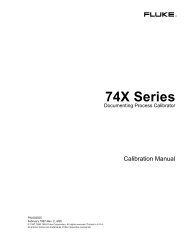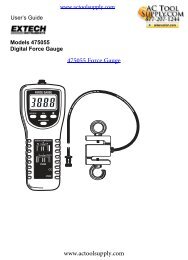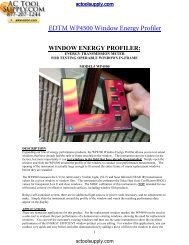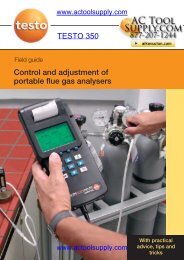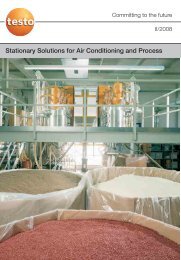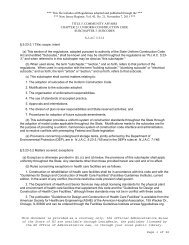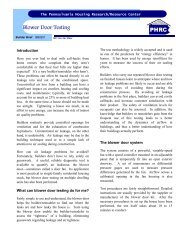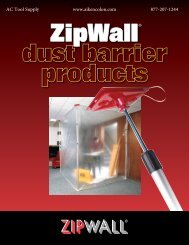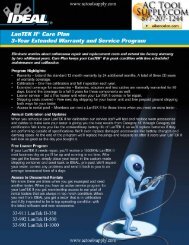MILLER DURAHOIST The - Honeywell Safety Products
MILLER DURAHOIST The - Honeywell Safety Products
MILLER DURAHOIST The - Honeywell Safety Products
Create successful ePaper yourself
Turn your PDF publications into a flip-book with our unique Google optimized e-Paper software.
USER INSTRUCTIONS - ENGLISH<br />
1.0 General Requirements<br />
Thank You<br />
We would like to thank you for your purchase of Miller Fall Protection equipment. Miller brand products are<br />
produced to meet the highest standards of quality at our ISO 9001:2000 certifi ed facility. <strong>The</strong>y are engineered to<br />
meet or exceed all applicable CE, EN, OSHA, ANSI, and CSA requirements and standards. Miller Fall Protection<br />
equipment will provide you with years of use, if cared for properly.<br />
WARNING<br />
All persons using this equipment must read and understand all instructions. Failure to do so may result in serious<br />
injury or death. Do not use this equipment unless you are properly trained.<br />
Questions?<br />
CALL<br />
1.800.873.5242<br />
It is crucial for the owner of this fall protection equipment to read and understand these instructions. In addition, it is<br />
also the employer’s responsibility to ensure that all users are trained in the proper use, inspection, and maintenance<br />
of fall protection equipment. Fall protection training should be an integral part of a comprehensive safety program.<br />
Proper use of fall arrest systems can save lives and reduce the potential of serious injuries from a fall. <strong>The</strong> user<br />
must be aware that forces experienced during the arrest of a fall or prolonged suspension may cause bodily injury.<br />
Consult a physician if there is any question about the user’s ability to use this product. Pregnant women and<br />
minors must not use this product.<br />
Limitations<br />
Consider the following application limitations before using this equipment:<br />
General Warnings<br />
•All warnings and instructions shall be provided to<br />
users. Warnings and instructions must be read<br />
and understood prior to using this equipment.<br />
•All users must reference applicable standard<br />
regulations governing occupational safety.<br />
•To minimize the potential for accidental<br />
disengagement, a competent person must ensure<br />
system compatibility.<br />
•All equipment must be visually inspected before<br />
each use.<br />
•Equipment must not be altered in any way.<br />
Repairs must be performed only by the<br />
equipment manufacturer, or persons or entities<br />
authorized, in writing, by the manufacturer.<br />
•Any product exhibiting deformities, unusual<br />
wear, or deterioration must be immediately<br />
discarded.<br />
•Any equipment subject to a fall must be removed<br />
from service.<br />
•<strong>The</strong> user shall have a rescue plan and the<br />
means at hand to implement it when using this<br />
equipment.<br />
•This product is designed for personal fall<br />
protection. Never use fall protection equipment<br />
for purposes other than those for which it was<br />
designed. Fall protection equipment should never<br />
be used for towing or hoisting.<br />
Capacity<br />
<strong>The</strong> maximum working load of Miller DuraHoist<br />
components is 450lbs (2.7kN) unless labeled<br />
otherwise. Refer to labeling on individual fall<br />
protection system components for capacities and<br />
warnings.<br />
Free Fall<br />
Personal fall arrest systems must be rigged to limit<br />
a free fall to 6ft/1.8m (according to ANSI Z359.1<br />
and ANSI A10.32).<br />
Fall Clearance<br />
Ensure that adequate clearance exists in your fall<br />
path to avoid striking an object. <strong>The</strong> amount of<br />
clearance required is dependent upon the type of<br />
connecting subsystem and anchorage location.<br />
Environmental Hazards<br />
Use of this equipment in areas where<br />
environmental hazards exist may require additional<br />
precautions to limit the possibility of injury to the<br />
user or damage to the equipment. Hazards may<br />
include, but are not limited to high heat, caustic<br />
chemicals, corrosive environments, high voltage<br />
power lines, explosive or toxic gases, moving<br />
machinery, and sharp edges. Polyester should be<br />
used in certain chemical or acidic environments.<br />
Consult the manufacturer in cases of doubt. All<br />
synthetic material must be protected from slag, hot<br />
sparks, open fl ames, or other heat sources. <strong>The</strong><br />
use of heat resistant materials is recommended in<br />
these applications.<br />
3



